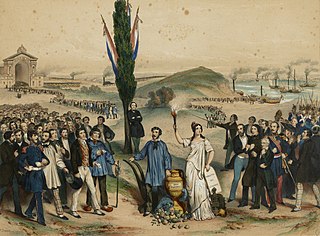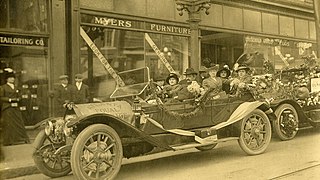This article needs additional citations for verification .(January 2021) |
Electoral reform in Georgia refers to efforts to change the voting laws in the Peach State.
This article needs additional citations for verification .(January 2021) |
Electoral reform in Georgia refers to efforts to change the voting laws in the Peach State.
The County unit system was prevented by court order from usage in the 1962, resulting in the election of Carl Sanders as first governor from an urban area in decades. The system was fully abolished in 1963 in Gray v. Sanders .
The white primary was abolished in the 1946 case King v. Chapman . [1]
On July 24, 1919, after Congress passed it, Georgia became the first state to reject the ratification of the Woman Suffrage Amendment with both houses passing resolutions against it. After Tennessee became the 38th and final state needed to ratify the amendment in August 1920, Georgia did not allow women to vote in the 1920 election citing a requirement that one must be registered six months before the election in order to vote. After the state refused to pass an "enabling act" to expedite suffrage, women would not get to vote in Georgia elections until 1922. Georgia would not ratify the amendment until February 20, 1970.
All qualified voters are allowed to vote absentee under Georgia law.
At city, county and state levels, referendums are only allowed through the support of 2/3 of both houses of the General Assembly. Only legislatively-referred constitutional amendments are allowed to be voted on by statewide referendum. In addition, county and city referendums must obtain a majority support from the county's delegation to the General Assembly.

The Nineteenth Amendment to the United States Constitution prohibits the United States and its states from denying the right to vote to citizens of the United States on the basis of sex, in effect recognising the right of women to a vote. The amendment was the culmination of a decades-long movement for women's suffrage in the United States, at both the state and national levels, and was part of the worldwide movement towards women's suffrage and part of the wider women's rights movement. The first women's suffrage amendment was introduced in Congress in 1878. However, a suffrage amendment did not pass the House of Representatives until May 21, 1919, which was quickly followed by the Senate, on June 4, 1919. It was then submitted to the states for ratification, achieving the requisite 36 ratifications to secure adoption, and thereby go into effect, on August 18, 1920. The Nineteenth Amendment's adoption was certified on August 26, 1920.

Suffrage, political franchise, or simply franchise, is the right to vote in public, political elections. In some languages, and occasionally in English, the right to vote is called active suffrage, as distinct from passive suffrage, which is the right to stand for election. The combination of active and passive suffrage is sometimes called full suffrage.

In political science, an initiative is a means by which a petition signed by a certain number of registered voters can force a government to choose either to enact a law or hold a public vote in the legislature in what is called indirect initiative, or under direct initiative, where the proposition is put to a plebiscite or referendum, in what is called a Popular initiated Referendum or citizen-initiated referendum.

Women's suffrage is the right of women to vote in elections. Beginning in the mid-19th century, aside from the work being done by women for broad-based economic and political equality and for social reforms, women sought to change voting laws to allow them to vote. National and international organizations formed to coordinate efforts towards that objective, especially the International Woman Suffrage Alliance, as well as for equal civil rights for women.
A constitutional amendment is a modification of the constitution of a polity, organization or other type of entity. Amendments are often interwoven into the relevant sections of an existing constitution, directly altering the text. Conversely, they can be appended to the constitution as supplemental additions, thus changing the frame of government without altering the existing text of the document.
Amendments to the Constitution of Ireland are only possible by way of referendum. A proposal to amend the Constitution of Ireland must first be approved by both Houses of the Oireachtas (parliament), then submitted to a referendum, and finally signed into law by the President of Ireland. Since the constitution entered into force on 29 December 1937, there have been 32 amendments to the constitution.

Elections in Kenya take place within the framework of a multi-party democracy and a presidential system. The President, Senate and National Assembly are directly elected by voters, with elections organised by the Independent Electoral and Boundaries Commission (IEBC).

An election for the National Assembly took place in Taiwan on Saturday, 14 May 2005, from 07:30 to 16:00 local time. It elected an ad hoc National Assembly whose only function was to serve as a constituent assembly in order to approve or reject amendments to the Constitution of the Republic of China already proposed by the Legislative Yuan. The results indicated that the amendments would be approved, as the parties supporting them won an overwhelming majority, and indeed the amendments were passed on 7 June 2005.
The Constitution of the State of Wisconsin is the governing document of the U.S. State of Wisconsin. It establishes the structure and function of state government, describes the state boundaries, and declares the rights of state citizens. The Wisconsin Constitution was written at a constitutional convention held in Madison, Wisconsin in December 1847 and approved by the citizens of Wisconsin Territory in a referendum held in March 1848. Wisconsin was admitted to the United States on May 29, 1848. Although it has been amended over a hundred times, the original constitution ratified in 1848 is still in use. This makes the Wisconsin Constitution the oldest U.S. state constitution outside of New England. Only Massachusetts, New Hampshire, Vermont, Maine, and Rhode Island use older constitutions.

Proposition 7 of 1911 was an amendment of the Constitution of California that introduced, for the first time, the initiative and the optional referendum. Prior to 1911 the only form of direct democracy in California was the compulsory referendum.
This timeline highlights milestones in women's suffrage in the United States, particularly the right of women to vote in elections at federal and state levels.

Women's suffrage in states of the United States refers to women's right to vote in individual states of that country. Suffrage was established on a full or partial basis by various towns, counties, states and territories during the latter decades of the 19th century and early part of the 20th century. As women received the right to vote in some places, they began running for public office and gaining positions as school board members, county clerks, state legislators, judges, and, in the case of Jeannette Rankin, as a Member of Congress.
This is a timeline of voting rights in the United States. The timeline highlights milestones when groups of people in the United States gained voting rights, and also documents aspects of disenfranchisement in the country.
This is a listing of noteworthy historical events relating to the international women's movement which occurred in 1919.

The 1920 United States presidential election in North Carolina took place on November 2, 1920, as part of the 1920 United States presidential election, which was held throughout all contemporary forty-eight states. Voters chose twelve representatives, or electors to the Electoral College, who voted for president and vice president.

This is a timeline of women's suffrage in Ohio. Women's suffrage activism in Ohio began in earnest around the 1850s, when several women's rights conventions took place around the state. The Ohio Women's Convention was very influential on the topic of women's suffrage, and the second Ohio Women's Convention in Akron, Ohio, featured Sojourner Truth and her famous speech, Ain't I a Woman? Women worked to create organizations and groups to influence politicians on women's suffrage. Several state constitutional amendments for women's suffrage did not pass. However, women in Ohio did get the right to vote in school board elections and in some municipalities before Ohio became the fifth state to ratify the Nineteenth Amendment.

Women's suffrage in Georgia received a slow start, with the first women's suffrage group, the Georgia Woman Suffrage Association (GWSA) formed in 1892 by Helen Augusta Howard. Over time, the group, which focused on "taxation without representation" grew and earned the support of both men and women. Howard convinced the National American Women's Suffrage Association (NAWSA) to hold their first convention outside of Washington, D. C. in 1895. The convention, held in Atlanta, was the first large women's rights gathering in the Southern United States. GWSA continued to hold conventions and raise awareness over the next years. Suffragists in Georgia agitated for suffrage amendments, for political parties to support white women's suffrage and for municipal suffrage. In the 1910s, more organizations were formed in Georgia and the number of suffragists grew. In addition, the Georgia Association Opposed to Woman Suffrage also formed an organized anti-suffrage campaign. Suffragists participated in parades, supported bills in the legislature and helped in the war effort during World War I. In 1917 and 1919, women earned the right to vote in primary elections in Waycross, Georgia and in Atlanta respectively. In 1919, after the Nineteenth Amendment went out to the states for ratification, Georgia became the first state to reject the amendment. When the Nineteenth Amendment became the law of the land, women still had to wait to vote because of rules regarding voter registration. White Georgia women would vote statewide in 1922. Native American women and African-American women had to wait longer to vote. Black women were actively excluded from the women's suffrage movement in the state and had their own organizations. Despite their work to vote, Black women faced discrimination at the polls in many different forms. Georgia finally ratified the Nineteenth Amendment on February 20, 1970.

This is a timeline of women's suffrage in Georgia. Women's suffrage in Georgia started in earnest with the formation of the Georgia Woman Suffrage Association (GWSA) in 1892. GWSA helped bring the first large women's rights convention to the South in 1895 when the National American Woman's Suffrage Association (NAWSA) held their convention in Atlanta. GWSA was the main source of activism behind women's suffrage until 1913. In that year, several other groups formed including the Georgia Young People's Suffrage Association (GYPSA) and the Georgia Men's League for Woman Suffrage. In 1914, the Georgia Association Opposed to Women's Suffrage (GAOWS) was formed by anti-suffragists. Despite the hard work by suffragists in Georgia, the state continued to reject most efforts to pass equal suffrage. In 1917, Waycross, Georgia allowed women to vote in primary elections and in 1919 Atlanta granted the same. Georgia was the first state to reject the Nineteenth Amendment. Women in Georgia still had to wait to vote statewide after the Nineteenth Amendment was ratified on August 26, 1920. Native American and African American women had to wait even longer to vote. Georgia ratified the Nineteenth Amendment in 1970.

This is a timeline of women's suffrage in Wisconsin. Women's suffrage efforts began before the Civil War. The first Wisconsin state constitutional convention in 1846 discussed both women's suffrage and African-American suffrage. In the end, a more conservative constitution was adopted by Wisconsin. In the 1850s, a German language women's rights newspaper was founded in Milwaukee and many suffragists spoke throughout the state. The first state suffrage convention was held in Janesville in 1867. The 1870s, several women's suffrage groups were founded in the state. In 1884, a women's suffrage bill, allowing women to vote for school-related issues is passed. In 1886, voters approve the school-related suffrage bill in a referendum. The first year women vote, 1887, there are challenges to the law that go on until Wisconsin women are allowed to vote again for school issues in 1902 using separate ballots. In the 1900s, women's suffrage conventions continue to take place throughout the state. Women collect petitions and continue to lobby the state legislature. In 1911 Wisconsin legislature passes a bill for women's suffrage that will go out to the voters in 1912. On November 4, 1912 voters disapprove of women's suffrage. Women's suffrage efforts continue, including sponsoring a suffrage school and with the inclusion of a National Woman's Party (NWP) chapter formed in 1915. When the Nineteenth Amendment goes out to the states, Wisconsin ratifies on June 10 and turns in the ratification paperwork first, on June 13, 1919.
Referendums in the Philippines are occasionally held at a national, regional or local level. Referendums can either by national or local in scope. In the Philippines, "referendums" and "plebiscites" mean different things.